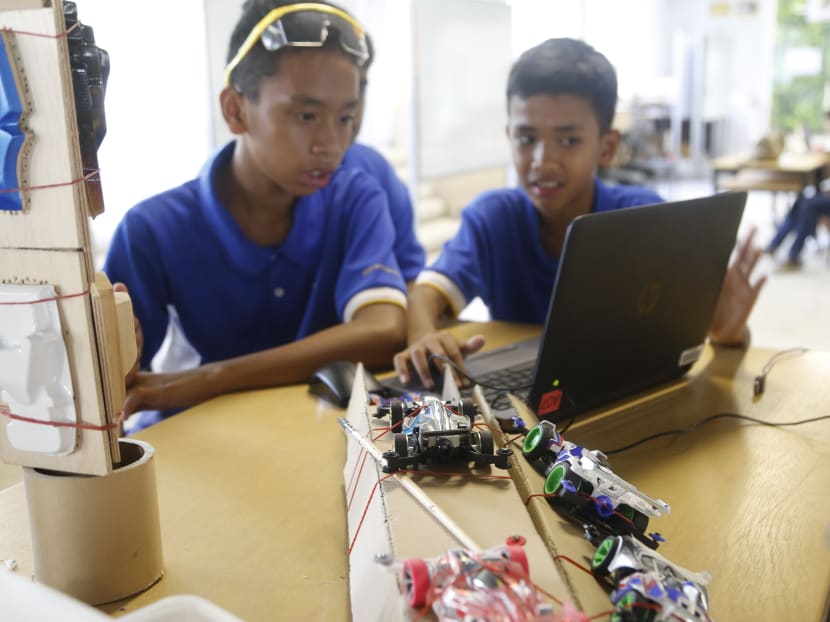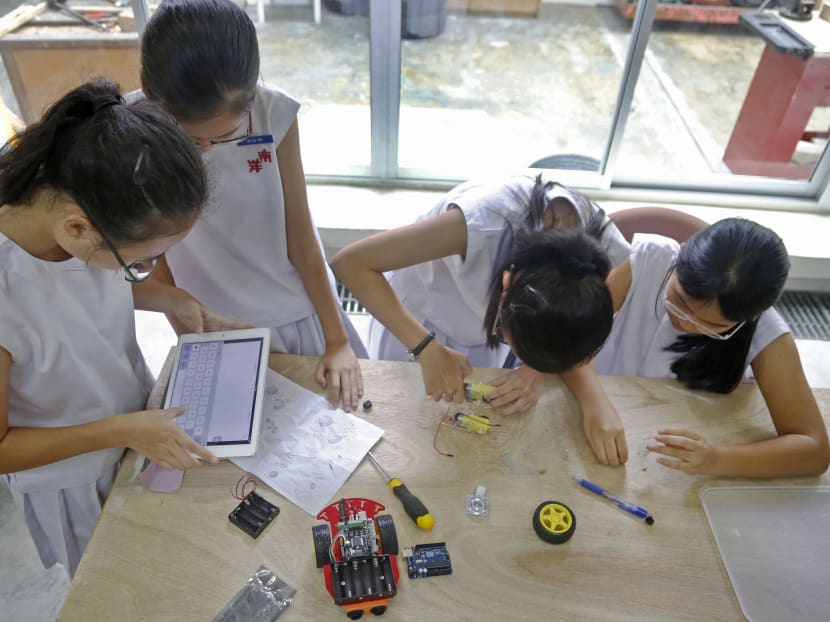‘Makerspaces’ allow students to get messy — and creative
SINGAPORE — An electrically-powered go-kart; a radio-controlled plane that glides at least one kilometre across the sky; and an alarm clock that tickles its owner awake. These are among the things students aspire to build with tools such as 3D printers, microcontrollers and laser cutters provided by their schools.


SINGAPORE — An electrically-powered go-kart; a radio-controlled plane that glides at least one kilometre across the sky; and an alarm clock that tickles its owner awake. These are among the things students aspire to build with tools such as 3D printers, microcontrollers and laser cutters provided by their schools.
More schools here are incorporating “maker education” into their curriculum, which encourages students to design and build objects that are meaningful personally or to the community.
“Makerspaces” — set aside for students to tinker with a wide range of high-tech equipment and materials — have also been set up in several secondary schools.
And the students love it.
At Commonwealth Secondary School, Dini Syazwan, 16, and Marshall Chong, 15, spend at least six hours each week at the school’s Design Space tinkering and brainstorming how best to let their RC-plane take flight.
The Secondary Three classmates cobbled together their current prototype by watching videos online and using self-sourced foamboard.
Since embarking on the project one month ago, the duo have gone through four rounds of creating the plane, experimenting with materials of different weight and textures.
“We will try and try again, until it works,” said Syazwan.
At other corners of the 300 sqm Design Space, groups of students are building virtual reality headsets out of cardboard and a mini-skate park played with fingerboards.
The space, among other things, was introduced after a curriculum review in 2013 to encourage creative thinking.
While it is not part of their formal curriculum, some 50 students from all levels drop by the space on “Maker Thursday” every week, and the place was abuzz with activity when TODAY visited.
Some take part in optional workshops conducted by teachers, while others work on their own projects, with ready assistance provided by design and technology teachers on duty.
The tinkering spirit is also alive at Tampines Secondary School, where students had opportunities to build LED shoes, scribbling machines and other robots during a makers’ camp last October.
With the help of students from the Singapore University of Technology and Design and Institute of Technical Education, the Tampines students tried their hand at digital fabrication equipment.
Amid growing interest, the school started weekly “making” workshops in April.
Held after school, these workshops are conducted by a team of four teachers, several of whom have experience and interest in engineering.
The school’s vice-principal, Ms Rose Chen, said: “These activities (give) students opportunities to apply what they have learnt in the classroom to solve real-life problems that are of interest to them.”
Teachers, too, find value in such self-directed learning. Mr Eugene Lee, who heads the school’s Research Innovation & Design department, said students learn to be resourceful and resilient.
“Making emphasises self-directedness and choice, so their creative pursuits are driven by interest and passion ... They also learn collaborative skills and the value of radical ideas,” said Mr Lee.
At Nanyang Girls’ High School, a similar space has been carved out at the school’s car park and furnished with a 3D printer, a soldering machine and a shelf with spanners, saws and cutters of various shapes and sizes.
About 40 girls hang out at the space on Monday afternoons as part of the school’s Student-Initiated Assessment programme, where students take on tasks to solve real-world problems.
But all other students are welcome to use it, said Mr Mark Shone, who is the school’s subject head of Relations and Communications, and a physics teacher.
He hopes the makerspace will hammer in values, such as perseverance and the spirit of improvising, in the students.
“Many are still not comfortable with prototyping and going through several iterations of the same product. But often, it is in trying to recover from their failures that they learn new skills,” Mr Shone said.
Schools can tap government schemes to support such programmes.
DesignSingapore Council is working with six secondary schools to pilot enrichment workshops in design thinking, where students design solutions to solve problems or needs in a community.
The Ministry of Education (MOE) also offers an annual fund of S$50,000 to develop Science, Technology, Engineering, Mathematics Applied Learning Programmes (STEM ALP), aimed at helping students to make a connection between science knowledge and real world applications. Seventy-one (71) secondary schools now have such programmes.
The MOE and STEM Inc, a unit established at the Science Centre in 2014, also offer support in designing activities for the programmes and connect schools with relevant partners.
Schools here can ride on the maker movement to provide opportunities for students to extend their learning and enhance schools’ engagement with the community, said an MOE spokesperson. Maker groups can work with the schools to conduct workshops for students and parents.
“(These can) provide opportunities to apply design thinking skills in community-oriented projects,” she said.
BEYOND THE 2Ts
Educators believe the maker movement goes beyond tools and technology.
Research scientist Dr Michael Tan, from the National Institute of Education, said fostering an innovative culture includes “embracing the messiness that may come with it”.
“A key component of maker pedagogy is the deliberate effort of educators to ‘get out of the way’ of learning, to recognise and nurture students’ initiatives ... I believe that changes to fundamental intentions and human capacities are needed,” said Dr Tan, who is working on a project to enhance Design and Technology programmes in 10 schools.
His words echoed that of former Education Minister Heng Swee Keat, who said during the opening of the annual Maker Faire last July: “Making is not about materials or things, it is about the spirit to overcome challenges, to innovate ...”
“To be a good maker, first you identify a problem you want to solve. Then you embark on a journey of discovery ... Basically, you learn,” Mr Heng added.






